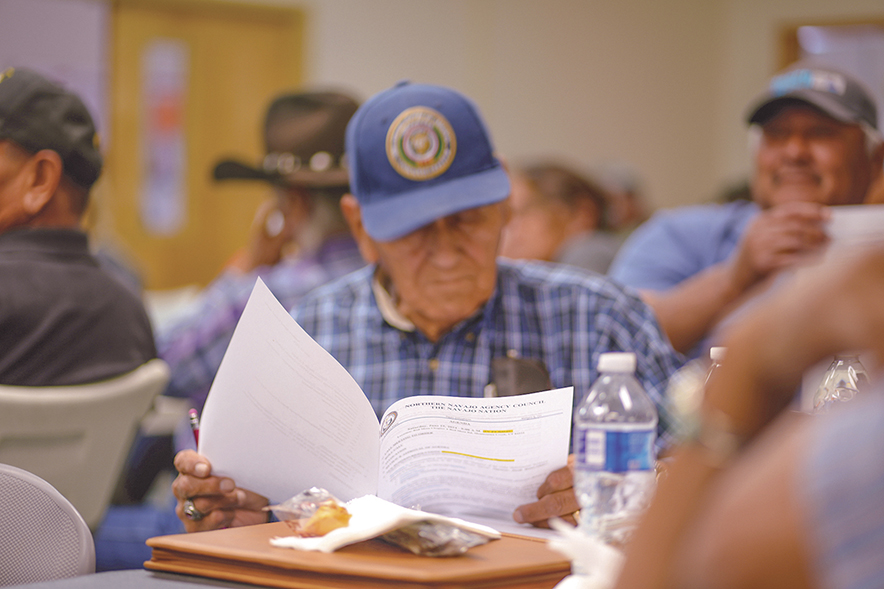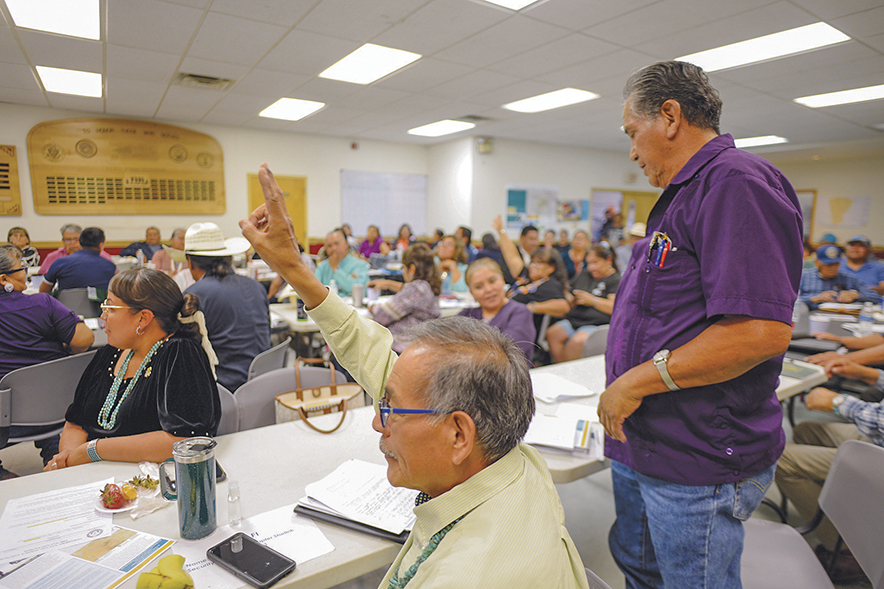
Navajo chapters gather in Red Mesa to address development initiatives

Special to the Times | Donovan Quintero
A chapter official reads through an agenda during the Northern Agency meeting on Saturday in Red Mesa, Ariz.
By Donovan Quintero
Special to the Times
RED MESA, Ariz. — Chapter leaders and community representatives from 19 Navajo Nation chapters convened at the Red Mesa Chapter on Saturday to receive updates on key issues impacting their communities. Topics included road improvement projects, house repairs, and senior center development.

Special to the Times | Donovan Quintero
Red Mesa Chapter President Herman Farley, center seated, raises his hands as he gestures to concur to adjourn the Northern Agency meeting on Saturday at the Red Mesa Chapter in Red Mesa, Ariz.
At the heart of the discussions were updates provided by tribal leaders on ongoing road improvement projects. These highlighted the progress made and the challenges that lie ahead in enhancing transportation infrastructure within and between Navajo communities.
President Buu Nygren, along with Speaker Crystalyne Curley, Council Delegates Brenda Jesus, Shawna Claw, Amber Crotty, Curtis Yanito, and Rickie Nez, responded to concerns from Aneth, Bitł’ááh Bito’, Cove, Gad ‘Íí’áí/Tókǫ’í, Mexican Water, Niinahnízaad, Newcomb, Red Mesa, Red Valley, Rock Point, Shiprock, T’iis Názbąs, T’iistsoh Sikaad, Toadlena/Two Grey Hills, Tółikan, Tooh Haltsooí, Tsé ‘Ałnáozt’i’í, Tsétaak’áán, and Upper Fruitland chapters, which represents nearly 31,000 Navajo people.
The Western Agency has 18 chapters, the Chinle Agency has 14 chapters, the Eastern Navajo Agency has 31 chapters, and the Fort Defiance Agency has 27 chapters.
Tółikan Chapter President Sarah Lee walked up to the podium when officials invited chapter leadership to speak and address Nygren and Curley about her chapter’s concerns. She told them she’d been emailing tribal leaders in Window Rock but was not getting any responses from either office.
“We’re still having problems out here with our roads within our chapter. I wanted to highlight that concern,” Lee said, partially speaking in Navajo as she talked to the leaders.
Lee went on to say she understands that each chapter would have 15 miles of their roads repaired or paved.
“Where is that taking us? ‘Ádin, we have ninety-eight miles in our community. ‘Ádin, when you drive three miles, the road is already wash-boarded and bumpy. And it takes like three more months to maintain it. Hxáájí? K’ad da’níyol,” Lee said, explaining that windy conditions quickly erased roads that heavy equipment grader smoothes.
Lee said that dirt roads in her chapter would get so bad that parts from vehicles, like mufflers, shocks, and even brakes, would be seen lying on the side of the road, as she alluded to the rough driving conditions contributing to vehicle breakdowns. She added that while many roads within the Tółikan Chapter boundary, she highlighted the 6.4-mile road improvement that was currently under construction. She thanked the Resource and Development Committee for helping improve the road.
“This has been a long time coming,” she said, emphasizing that it took 50 years of collaborative work between the tribe and BIA to make the road improvement a reality.
Lee added that part of the road has already been under construction, which began in 2014.
“All of us, from young to old, use our reservation roads. When I was in high school and I attended Shiprock High School, we used to get up at four or five in the morning, rain or shine, we went to school,” Lee shared. “It’s not in those times anymore — things have changed. So, I think our requests to get our roads improved is for our children. Roads are probably in need of repair, reservation-wide. I just wanted to voice those concerns.”
T’iis Názbąs issues
T’iis Názbąs Chapter president Kenny Victor was next to speak. After thanking the tribal leaders, he began sharing an elderly community member’s Navajo Tribal Utility Authority electricity bill issue.

Special to the Times | Donovan Quintero
Council delegates, chapter officials, and staff from the executive and legislative branches filled the Red Mesa Chapter meeting area on Saturday during the Northern Agency meeting in Red Mesa, Ariz.
“I have an eighty-four-year-old that came back to the area, to her home. Áádóó, she was there and she has medical problems. Áádóó, they turned off her water, but she was paying her bills,” Victor said. “I’m gonna use this as an example, and I’m gonna vector off this story. We live in an area where there’s fixed income, nothing but elders. Áádóó, doo nidaalnishda. They’re disabled. Akó, these utility rates keeps going higher and higher. Áko, díidí NTUA, they can afford brand new pickups, very brand new pickups. Is this one of the reasons why they’re raising our utility rates, so they can benefit from us?”
According to an April 2023 Navajo Times story, NTUA Deputy Chief Financial Officer Gerard Curley said four components determined the overall billing charging for NTUA customers: the usage charge, service charge, power charge, and the overall tax for the charges.
Times reporter David Smith reported that some NTUA customers said they saw an increase of hundreds of dollars and became concerned their utilities would be shut off. Smith noted that Chinle Chapter President Rosanna Jumbo-Fitch was concerned for low-income families, single parents, and others who struggled with the cost of living. She has also been hearing the complaints of high NTUA bills and said the company needed to do better to keep the people updated on billing costs and what could be done.
Victor said the tribally-owned utility’s billing practices bothered him.
“These entities are out of control. How is it so?” Victor asked.
Read the full story in the June 20, edition of the Navajo Times.







 Highway 264,
Highway 264, I-40, WB @ Winslow
I-40, WB @ Winslow